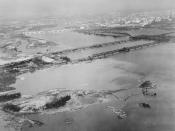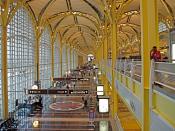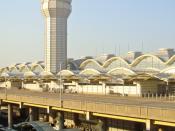Abstract
This report provides an overview of the Ronald Regan Washington National Airport's past and future problems with construction design, environmental concerns and political troubles. Section I of the report provides an introduction to the airport and its history of construction. Section II talks about the main terminal design and the concerns it raised along with the first legal troubles. Section III presents overview of expansion of the National Airport. Section IV describes the efforts of preserving the Colonial history of the Abingdon plantation on the airport land. Section V describes the political efforts to overcome help the airport in revitalization. The final section summarizes the main points of the paper.
I.Brief History
Hoover Field, located near the present day site of the Pentagon, was the first major airport terminal in the Washington D.C. area in 1926. The following year, Washington Airport, another privately operated field, began service next door to Hoover Field.
In 1930, the economics of the Great Depression caused the two terminals to merge to form the Washington -Hoover Airport. Bordered on the East by Route 1, with its accompanying high-tension electrical transmission wires and obstructed by a high smokestack on one approach and a dump nearby, the field was less than adequate. The need for a new airport was apparent (MWAA 2003).
Between 1926 and 1938, Congress produced reams of debate transcripts and 37 committee reports on the need for a new airport, but no action was taken. Finally, in the fall of 1938, then President Franklin D. Roosevelt announced that he was "tried of waiting for Congress" to select a site for a proposed new airport and said that it would be built on the mudflats on the bend of the Potomac River at Gravelly Point, 4 ý miles south of Washington D.C.


